Whiteflies, scientifically known as Aleyrodidae, are a family of small, winged insects often found infesting houseplants. Despite their name, they are not true flies but are more closely related to aphids and mealybugs. According to a study published in the Annual Review of Entomology, there are over 1,500 species of whiteflies worldwide, with a few species such as the greenhouse whitefly and silverleaf whitefly being particularly problematic for horticulture.
These tiny insects, usually no larger than 1/12 of an inch, are known for their plant-sap feeding habits, which can cause significant damage to plants, including stunted growth, yellowing leaves, and even plant death in severe cases. Moreover, they can transmit harmful plant viruses, adding to their destructive potential.
This article provides a comprehensive guide on how to identify and get rid of whiteflies on houseplants. It covers everything from understanding the biology of whiteflies, recognizing the signs of an infestation, to practical and effective methods for their control. The aim is to equip you with the knowledge and tools to protect your indoor greenery from these pesky pests.
What are Whiteflies and Why are they a Problem for Houseplants?
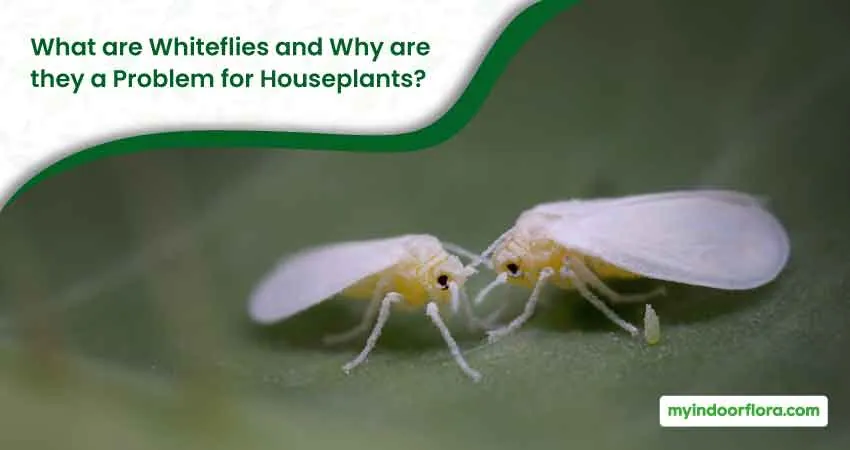
Whiteflies, tiny as they are, pose a colossal threat to the health of houseplants. These insects, often no larger than a couple of millimeters, are part of the Aleyrodidae family, and despite their name, they are more closely related to aphids and mealybugs than actual flies. They’re easy to identify thanks to their white, waxy wings that resemble a minuscule moth when in flight.
Whiteflies are not merely annoying; they are downright destructive. They suck the sap from the leaves of houseplants, robbing them of essential nutrients. When whiteflies feed, they excrete a sticky substance known as honeydew. This sweet-tasting substance attracts other pests and can lead to the development of sooty mold, further impacting the health of your plant.
The Lifecycle of Whiteflies
Understanding the lifecycle of whiteflies can offer essential insights into the extent of an infestation. It also plays a pivotal role in determining the best control methods.
The lifecycle begins with the female laying her eggs on the underside of leaves. These eggs hatch into nymphs, which go through a few developmental stages before becoming full-grown adults.
This lifecycle can take anywhere from 16 to 30 days, depending on environmental conditions.
Detecting whiteflies early on can save your plants a lot of stress. The initial signs of whitefly damage can be subtle, so vigilance is key. You might notice a slight yellowing or wilting of leaves, or perhaps a sticky residue on the surface of leaves or nearby furniture. A severe infestation can lead to stunted growth, leaf drop, and even plant death.
How to Identify a Whitefly Infestation on Houseplants?
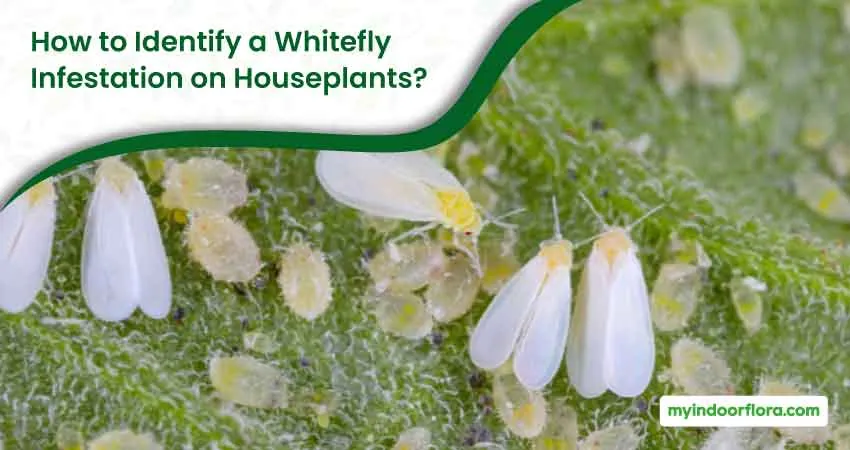
Identification of a whitefly infestation is the first crucial step in dealing with these pesky invaders. This requires careful observation and understanding of the various signs that indicate their presence.
Signs of a Whitefly Infestation
Whiteflies leave several signs of their presence and activity. Below are some of the most common ones:
- Leaf Yellowing and Curling: Whiteflies feed on plant sap, causing the leaves to turn yellow and curl over time.
- Stunted Growth: As these pests draw out the nutrients, the growth of your plants can be severely impacted.
- Presence of White Flies: The most telling sign is the presence of small, white, moth-like insects around your plants. They often congregate on the underside of leaves.
- Honeydew Secretion: Whiteflies excrete a sticky substance called honeydew, which can attract other pests and lead to sooty mold.
- Eggs or Larvae on the Underside of Leaves: Whiteflies lay tiny, cigar-shaped eggs and develop scale-like larvae, typically found on the underside of leaves.
Whiteflies vs. Aphids & Mealybugs
It’s worth noting that whiteflies can often be confused with other small, white pests like aphids or mealybugs. The table below outlines the differences:
| Characteristics | Whiteflies | Aphids | Mealybugs |
|---|---|---|---|
| Size | 1-2 mm | 1-3 mm | Up to 5 mm |
| Color | White | Varies, can be white, green, yellow, black | White, covered in a waxy substance |
| Shape | Moth-like with wings | Pear-shaped, usually wingless | Oval, segmented bodies |
| Mobility | Fly away when disturbed | Typically crawl away slowly | Slow-moving, less active |
| Honeydew Production | Yes | Yes | Yes |
Regular monitoring of your houseplants is key to early detection of a whitefly infestation. Be sure to examine your plants closely, especially the underside of the leaves. Remember, the quicker you identify the presence of whiteflies, the easier it will be to control and eliminate them.
How does the Lifecycle of Whiteflies Impact Houseplants?
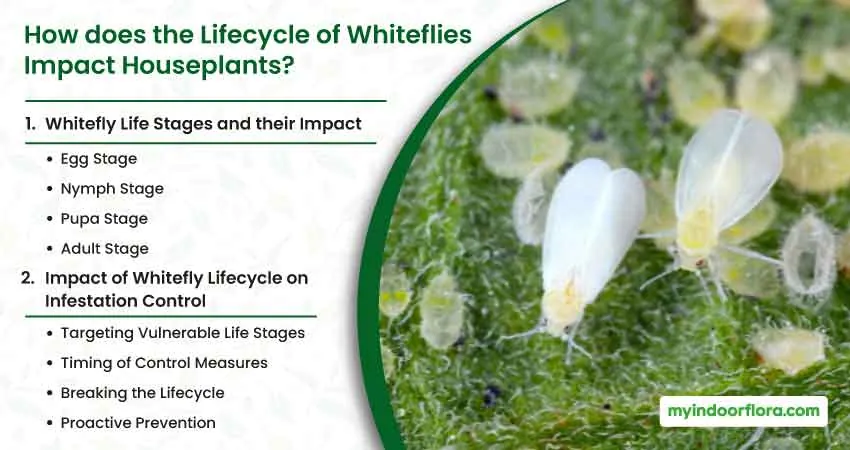
Understanding the lifecycle of whiteflies is instrumental in combating their destructive impact on houseplants. Whiteflies have a four-stage life cycle, including eggs, nymphs (also called crawlers), pupae, and adults. Each of these stages has specific implications for the plants they inhabit.
Whitefly Life Stages and their Impact
- Egg Stage: Whitefly females lay their eggs on the underside of leaves. The eggs are tiny, cigar-shaped, and range from a pale yellow to almost transparent color. During this stage, the eggs are generally harmless to the plant, but their presence signals a potential infestation that could become a problem in the future.
- Nymph Stage: After about a week, the eggs hatch into nymphs. This stage is often overlooked since the nymphs are stationary and blend well with the leaf color. However, this is the stage where the damage starts as the nymphs begin feeding on the plant’s sap, depriving it of essential nutrients.
- Pupa Stage: After going through a few molting stages, the nymphs turn into pupae. In this stage, they continue to feed on the plant’s sap while preparing to transform into adults. This constant feeding not only weakens the plant but also leads to honeydew secretion, which can lead to sooty mold growth and attract other pests.
- Adult Stage: After pupation, adult whiteflies emerge. These small, winged insects continue to feed on the plant’s sap and lay eggs, continuing the cycle. The adults are often the first visible sign of an infestation, as they fly away when the plant is disturbed.
Understanding the duration of each life stage is vital, as it can influence the timing and effectiveness of control measures. Here is a table outlining the approximate duration of each life stage under typical indoor conditions:
| Life Stage | Duration |
|---|---|
| Egg Stage | 5 to 7 days |
| Nymph Stage | 14 to 21 days |
| Pupa Stage | 7 to 10 days |
| Adult Stage | 15 to 30 days |
Impact of Whitefly Lifecycle on Infestation Control
The lifecycle of whiteflies and its understanding can significantly influence the success of your infestation control measures. Here’s how:
- Targeting Vulnerable Life Stages: All stages of the whitefly lifecycle are not equally susceptible to control measures. Adult whiteflies and nymphs are the stages most vulnerable to insecticides and other control methods, while the eggs and pupae are often resistant. Understanding this aspect can guide your strategy, ensuring that you target the most susceptible life stages for more effective control.
- Timing of Control Measures: Whiteflies reproduce rapidly, and new generations can emerge every 20-30 days under optimal conditions. This fast reproduction rate means that if control measures aren’t timed correctly, a new generation of whiteflies could be developing unaffected. Knowledge of the lifecycle can guide the timing of your control measures, ensuring that they are implemented when most effective and repeated as necessary to catch emerging generations.
- Breaking the Lifecycle: Whiteflies’ lifecycle is continuous, with overlapping generations living on the same plant. Breaking this cycle is key to controlling and preventing infestations. Methods aimed at disrupting the lifecycle, such as removing infested leaves (where eggs and nymphs may be present) or introducing biological controls (like parasitic wasps that target nymphs), can be effective when used as part of a comprehensive control strategy.
- Proactive Prevention: Understanding the whitefly lifecycle also provides the foundation for proactive prevention. For example, knowing that whiteflies lay their eggs on the undersides of leaves can encourage regular leaf checks, allowing you to spot and respond to infestations in their earliest stages.
What Indoor Plants are Most Susceptible to Whitefly Infestation?
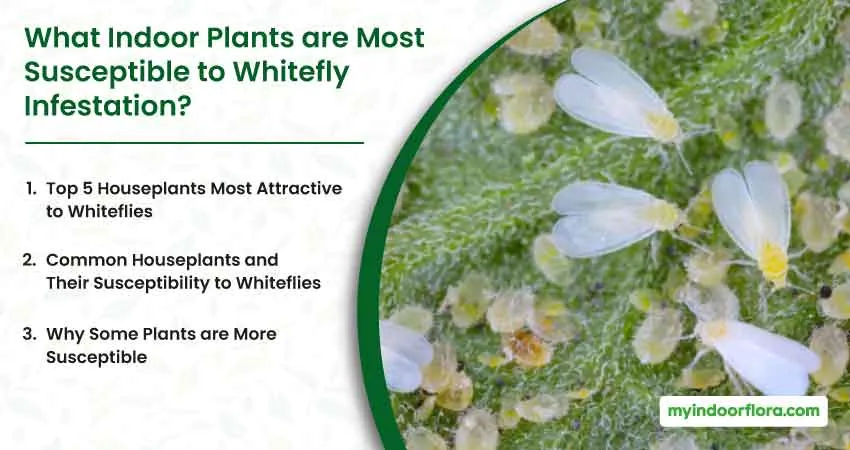
Every plant owner dreads the sight of whiteflies. However, these pests don’t invade all houseplants equally. Certain plant species are more susceptible and serve as a magnet for whiteflies due to their specific characteristics such as the texture of their leaves and their nutritional content.
Top 5 Houseplants Most Attractive to Whiteflies
- Ficus (Ficus benjamina): Commonly known as weeping fig, this popular houseplant often falls prey to whiteflies. Their lush, glossy leaves provide ample feeding grounds for these pests.
- Hibiscus (Hibiscus rosa-sinensis): Hibiscus plants are whitefly favorites, especially those grown in indoor conditions. The tender, broad leaves offer an ideal site for whitefly infestations.
- Poinsettia (Euphorbia pulcherrima): As a favorite during the holiday season, poinsettias often suffer from whitefly attacks, particularly from a species known as the silverleaf whitefly.
- Geranium (Pelargonium): These flowering plants are a delight to gardeners but are unfortunately equally attractive to whiteflies.
- Citrus (Citrus spp.): Indoor citrus trees, such as lemons and oranges, are susceptible to a type of whitefly called the citrus whitefly.
Common Houseplants and Their Susceptibility to Whiteflies
Below is a table that provides a broader list of common houseplants and their susceptibility to whiteflies.
| Houseplant | Susceptibility Level | Comments |
|---|---|---|
| Ficus | High | Preferred due to large, glossy leaves |
| Hibiscus | High | Attractive due to broad, tender leaves |
| Poinsettia | High | Frequently attacked by silverleaf whiteflies |
| Geranium | High | Beautiful blooms attract whiteflies |
| Citrus | High | Prone to citrus whitefly attacks |
| Begonia | Moderate | Susceptible but not a primary target |
| Tomato | Moderate | Indoor tomato plants can attract whiteflies |
| Orchid | Low | Less likely to be infested, but it’s not immune |
| Snake Plant | Low | Its tough leaves are less appealing to whiteflies |
| ZZ Plant | Low | Resistant due to its waxy leaves |
Why Some Plants are More Susceptible
According to a study published in the Journal of Chemical Ecology, whiteflies are attracted to specific plant compounds. The sweetness of the sap, the tenderness of the leaves, and even the color of the plant can influence a whitefly’s preference. High-nitrogen plants also tend to be more attractive to whiteflies. Hence, over-fertilization can inadvertently increase the susceptibility of your houseplants to these pests.
Additionally, whiteflies are known to prefer plants that are stressed or unhealthy, as per a study in Pest Management Science. Maintaining the overall health of your plants can make them less appealing to these pests.
By knowing which houseplants are most susceptible to whitefly infestation, you can take preventative measures to protect these plants and manage potential outbreaks effectively.
How to Prevent Whiteflies from Infesting Houseplants?
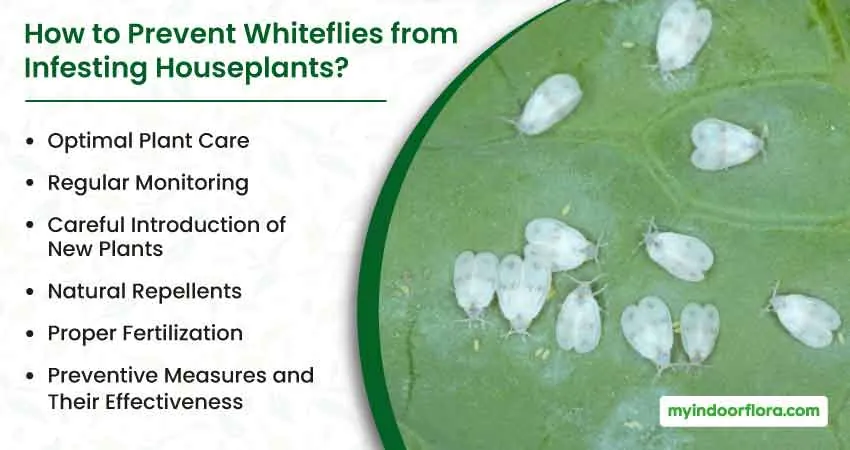
Prevention is always better than cure, especially when dealing with whiteflies on houseplants. By taking a few preventative measures, you can significantly reduce the likelihood of a whitefly infestation. Here’s a deeper look into what experts suggest:
Optimal Plant Care
The health of your plants plays a significant role in preventing whitefly infestations. A study published in Environmental Entomology revealed that stressed and unhealthy plants tend to attract more whiteflies. Thus, proper watering, feeding, and light exposure can enhance your plant’s resilience against these pests.
Regular Monitoring
Checking your plants regularly is an effective way of catching the early signs of a whitefly infestation. Pay special attention to the underside of leaves, as this is where whiteflies tend to lay their eggs. The sooner you can detect their presence, the better your chances of preventing a full-blown infestation.
Careful Introduction of New Plants
New plants can bring whiteflies into your home without you knowing. Before introducing a new plant to your collection, quarantine it and inspect it thoroughly for any signs of pests. If you notice any whiteflies, treat the plant before placing it with the rest of your plants.
Natural Repellents
Certain plants can deter whiteflies naturally due to their scent or the compounds they produce. According to the University of California Statewide Integrated Pest Management Program, plants like marigold, nasturtium, and sweet alyssum can help deter whiteflies. Consider incorporating these into your indoor plant collection for their natural repellent properties.
Proper Fertilization
As mentioned before, high-nitrogen plants tend to attract whiteflies. Hence, it’s essential to avoid over-fertilization, which can lead to excessive nitrogen levels. Use fertilizers as directed and consider using slow-release forms to avoid a sudden spike in nutrients.
Preventive Measures and Their Effectiveness
The table below summarizes some preventive measures and their effectiveness based on expert opinion:
| Preventive Measure | Effectiveness |
|---|---|
| Optimal Plant Care | High |
| Regular Monitoring | High |
| Quarantine New Plants | High |
| Use of Natural Repellents | Moderate |
| Proper Fertilization | Moderate |
Dr. Whitney Cranshaw, an entomologist at Colorado State University, emphasizes the importance of early detection and the use of natural enemies to keep whitefly populations in check. He suggests that introducing beneficial insects such as parasitic wasps can help control whitefly infestations.
Conversely, John Sanderson, an associate professor in the Department of Entomology at Cornell University, stresses the role of environmental factors. He advises maintaining optimal growing conditions for your plants to make them less appealing to whiteflies.
How to Get Rid of Whiteflies: 9 Effective Ways
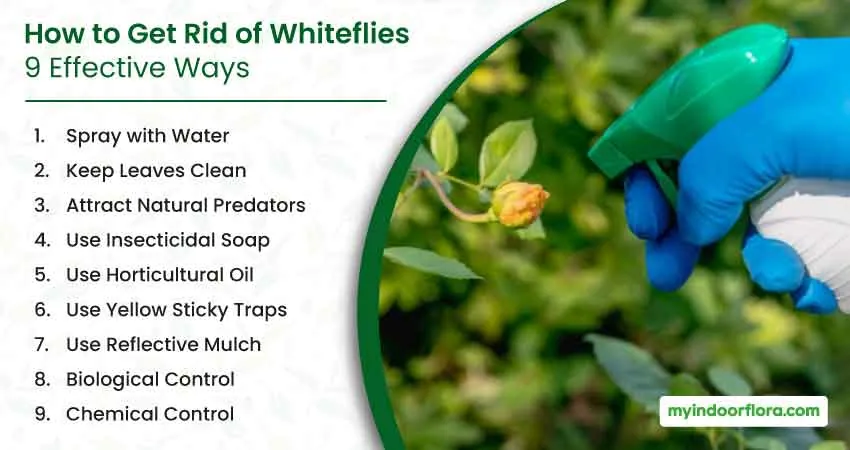
If you’ve identified a whitefly infestation, it’s time to take action. Here are some practical and effective methods to get rid of whiteflies. Each method is explained in detail, with expert opinions, analysis, and actionable steps.
1. Spray with Water
The first line of defense against whiteflies is a simple spray of water. According to experts, a strong jet of water can dislodge whitefly eggs and nymphs from the underside of leaves. Because nymphs don’t move after the initial creeping phase, they will starve and die when removed from their food source. This method is most effective in the early stages of infestation and can be repeated as necessary.
2. Keep Leaves Clean
Keeping your plant leaves clean can help control honeydew and mold, which are often associated with whitefly infestations. Wipe down affected leaves with a damp cloth or spray with water. This simple practice can help control the population of whiteflies on your plants and prevent the spread of diseases.
3. Attract Natural Predators
Nature has its own pest control in the form of beneficial insects that prey on whiteflies. These natural enemies include ladybugs, green lacewings, dragonflies, and whitefly parasite wasps. According to a study published in the Journal of Economic Entomology, these predators can significantly reduce whitefly populations when present in sufficient numbers.
To attract these beneficial insects, plant a variety of flowering plants in your garden. Certain plants, such as marigolds and nasturtiums, are known to attract ladybugs. You can also purchase these beneficial insects from garden centers and online stores to release into your garden.
4. Use Insecticidal Soap
Insecticidal soaps are a safe and effective way to control whiteflies. These soaps work by coating the eggs, larvae, and adults, suffocating them. It’s important to apply the soap directly to the insects and to thoroughly cover the underside of leaves where whiteflies often reside.
For a homemade insecticidal soap, mix 1 tablespoon of Castile soap with 1 quart of water. Spray the mixture on the affected plants in the early morning or evening when temperatures are cooler. Repeat the application every 4 to 7 days until the infestation is under control.
5. Use Horticultural Oil
Horticultural oils, such as neem oil, can also be effective against whiteflies. These oils work by suffocating the pests and disrupting their feeding. According to a study published in the Journal of Pest Science, neem oil was found to be a potent biopesticide against whiteflies.
To use, mix the horticultural oil as per the instructions on the label and spray it on the affected plants. Make sure to cover the underside of the leaves where whiteflies are often found. Repeat the application as necessary until the infestation is under control.
6. Use Yellow Sticky Traps
Yellow sticky traps are a non-toxic way to control whiteflies. These traps are coated with a sticky substance that traps whiteflies when they land on it. According to a study published in the Journal of Applied Entomology, yellow sticky traps were found to be effective in reducing whitefly populations in greenhouses.
To use, place the traps near the affected plants. The traps should be positioned at the same height as the plant canopy where whiteflies are most active. Check the traps regularly and replace them when they are covered with insects.
7. Use Reflective Mulch
Reflective mulches can deter whiteflies by confusing them with reflected light. A study published in the Journal of Integrated Pest Management found that silver reflective mulch significantly reducedwhitefly populations in vegetable crops. To use this method, cover the ground around your plants with a reflective mulch, such as silver plastic or aluminum foil. This can be particularly effective in outdoor gardens.
8. Biological Control
Biological control involves using natural enemies of the whiteflies to control their population. Parasitic wasps, such as Encarsia formosa and Eretmocerus eremicus, are known to be effective biological control agents for whiteflies. These tiny wasps lay their eggs inside whitefly nymphs, killing them.
According to a research published in the BioControl journal, these parasitic wasps can provide effective control of whiteflies in greenhouse settings. You can purchase these beneficial insects from commercial suppliers and release them into your garden or greenhouse.
9. Chemical Control
While chemical control should be a last resort due to potential harm to beneficial insects and the environment, there are times when it may be necessary. Insecticides that are effective against whiteflies include products containing the active ingredients imidacloprid, pyriproxyfen, and spiromesifen.
However, it’s important to note that some populations of whiteflies have developed resistance to certain insecticides. Therefore, it’s crucial to rotate different types of insecticides if multiple applications are necessary.
How to Repair and Revive Whitefly-Damaged Houseplants?
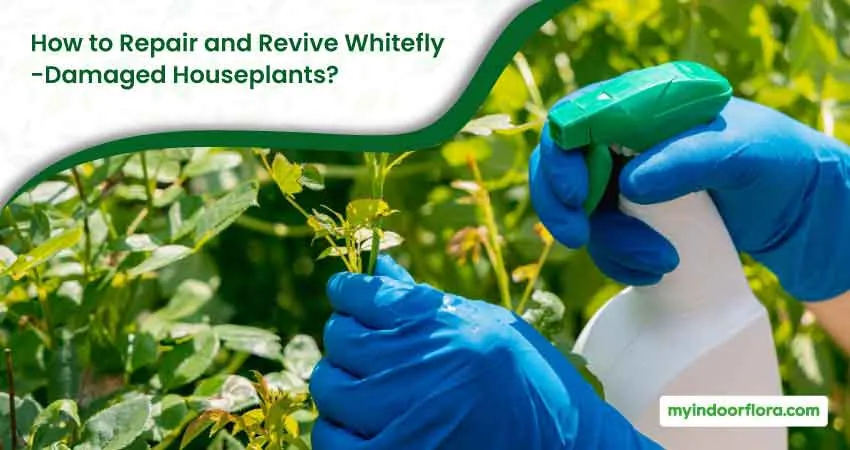
Whitefly infestations can take a toll on your houseplants, but with a bit of TLC, they can bounce back.
- Once you’ve addressed the whitefly problem, it’s time to focus on plant recovery. Providing optimal care, including proper watering and fertilization, can help your plants recuperate. Removing severely damaged leaves can also promote new, healthy growth.
- Pruning can be an effective way to encourage growth after an infestation. Removing affected leaves allows the plant to direct its energy towards new growth. Additionally, ensuring your plant gets the right amount of light can also aid recovery.
- Once your plant is on the road to recovery, ongoing care is essential to prevent reinfestation. Continue monitoring your plants for signs of whiteflies and take prompt action if you spot any.
How to Maintain a Whitefly-Free Environment for Houseplants?
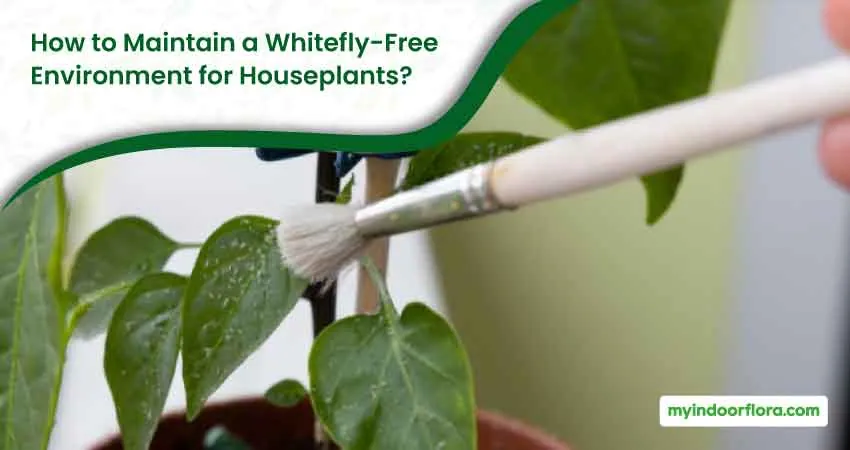
Keeping your indoor garden free from whiteflies requires a combination of vigilance and ongoing care.
- Create A Healthy Environment: Creating a healthy environment for your plants can deter whiteflies. Regular cleaning and maintenance, correct watering practices, and providing the right amount of light can keep your plants strong and less attractive to pests.
- Routine Inspection: Set up a regular schedule for checking your plants for pests. Promptly addressing any signs of infestation can prevent the problem from escalating. Likewise, regularly treating your plants with a mild insecticidal soap, even when there’s no sign of pests, can prevent future infestations.
- Proper Plant Care: Proper plant care goes beyond watering and providing light. Regular feeding, repotting when necessary, and maintaining the right temperature and humidity levels can all contribute to healthier plants that are more resistant to pests.
Conclusion
Dealing with whiteflies on your houseplants can be a challenge, but armed with the right knowledge, you can keep these pests in check. From understanding their lifecycle to knowing how to spot an infestation, every piece of information brings you one step closer to maintaining a healthy, whitefly-free indoor garden. Remember, consistent care and vigilance are your best allies in this fight. Keep your plants happy, and they’ll reward you with their vibrant, uplifting presence, free from the threat of whiteflies.
